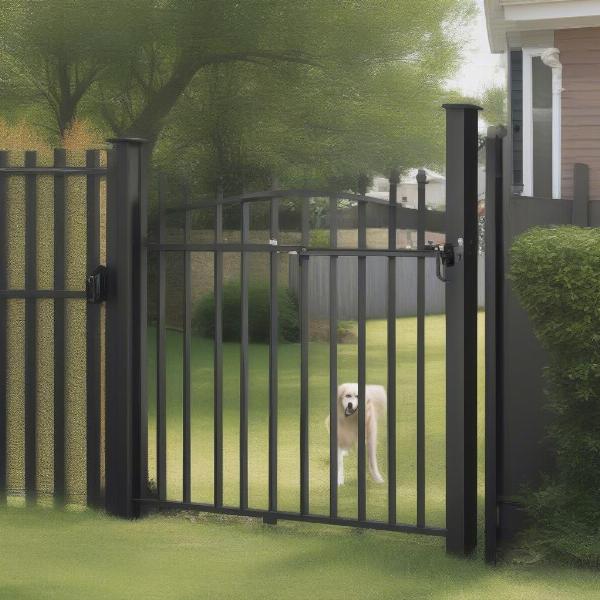A curious nose and boundless energy can sometimes lead our furry friends into trouble. “1 dozen dog-proof traps” refers to identifying and neutralizing common household hazards that can pose risks to our canine companions. From tempting toxins to precarious perches, understanding these potential dangers is crucial for responsible dog ownership. This guide explores 12 common household hazards and provides practical solutions to ensure your dog’s safety.
Toxic Temptations: Protecting Your Pup from Poison
Many common household items can be surprisingly toxic to dogs. Cleaning products, certain human foods like chocolate and grapes, and even some houseplants can cause severe illness or even death if ingested. Securely store all cleaning supplies and medications out of reach, and be mindful of what food scraps fall to the floor. Research pet-safe houseplants and remove any toxic varieties from your home.
Electrical Hazards: Keeping Cords Out of Reach
Chewing on electrical cords can cause burns, electrocution, and other serious injuries. Use cord covers or conceal cords behind furniture to make them less accessible. Provide plenty of chew toys to redirect your dog’s chewing instincts.
Securing the Perimeter: Preventing Escapes and Intrusions
A securely fenced yard is essential for preventing escapes and keeping unwanted animals out. Check for gaps or weak spots in your fence regularly and make necessary repairs promptly. Ensure gates are securely latched at all times.
 Secure Dog Fence
Secure Dog Fence
Kitchen Dangers: Avoiding Culinary Calamities
The kitchen can be a hazardous zone for dogs. Hot stoves, sharp knives, and tempting food left unattended can all pose risks. Never leave food cooking unattended and store sharp objects safely. Use childproof latches on cabinets containing potentially harmful substances.
Bathroom Hazards: Keeping Medications and Cleaners Secure
Medications, cleaning products, and even seemingly harmless items like cotton swabs can be dangerous for dogs if ingested. Store all bathroom products in secure cabinets or drawers out of your dog’s reach.
Preventing Falls: Securing Windows and Balconies
Dogs, especially smaller breeds, can easily fall from windows or balconies. Install screens or guards to prevent falls, and never leave windows open unsupervised.
Garage and Garden Dangers: Protecting Your Pup from Chemicals and Tools
Garages and gardens often contain chemicals, fertilizers, and sharp tools that can be harmful to dogs. Store these items safely and securely, and supervise your dog when they are in these areas.
Holiday Hazards: Avoiding Festive Dangers
Holidays can introduce new hazards for dogs. Decorations, festive foods, and increased activity can all pose risks. Keep decorations out of reach, be mindful of toxic holiday plants like poinsettias, and avoid feeding your dog table scraps.
Protecting Your Furniture: Preventing Chewing and Scratching
Provide appropriate chew toys and scratching posts to redirect your dog’s natural instincts away from your furniture. Consider using furniture covers or sprays to deter destructive behavior.
Safeguarding Your Belongings: Preventing Destructive Chewing
Keep valuable items and personal belongings out of reach to prevent destructive chewing. Provide plenty of engaging toys and activities to keep your dog occupied and entertained.
Preventing Choking Hazards: Choosing Safe Toys
Select toys that are appropriately sized for your dog and made of durable materials. Avoid toys with small parts that can be easily chewed off and swallowed.
Creating a Safe Space: Providing a Secure Den
Provide your dog with a safe and comfortable den or crate where they can retreat when feeling stressed or overwhelmed. This can be a valuable tool for preventing anxiety-related destructive behaviors.
Conclusion: A Proactive Approach to Dog Safety
Implementing these “1 dozen dog-proof traps” creates a safer environment for your beloved companion. By proactively addressing potential hazards, you can minimize risks and ensure your dog enjoys a long, healthy, and happy life. Remember, a safe dog is a happy dog!
Frequently Asked Questions
- What are the most common household poisons for dogs? Chocolate, grapes, raisins, onions, garlic, xylitol (artificial sweetener), and certain cleaning products are common household toxins for dogs.
- How can I prevent my dog from chewing on electrical cords? Use cord covers, conceal cords behind furniture, and provide plenty of chew toys.
- What are some safe chew toys for dogs? Look for durable toys made of non-toxic materials, and avoid toys with small parts that can be swallowed.
- How can I make my yard safe for my dog? Ensure your fence is secure with no gaps or weak spots, and keep gates securely latched.
- What should I do if my dog ingests something toxic? Contact your veterinarian or a pet poison control center immediately.
Related articles:
(Only include if relevant articles exist on ilmdog.com. Insert actual links to relevant articles if found.)
About ILM Dog
ILM Dog is your trusted global resource for comprehensive dog care and nurturing advice. We offer expert guidance on a range of topics, including breed selection, health and medical care, training, nutrition, grooming, and product recommendations. Our mission is to empower dog owners worldwide with the knowledge and resources they need to provide the best possible care for their canine companions. Whether you’re a seasoned dog owner or just starting your journey, ILM Dog is here to support you every step of the way. Contact us at [email protected] or +44 20-3965-8624 for personalized guidance.